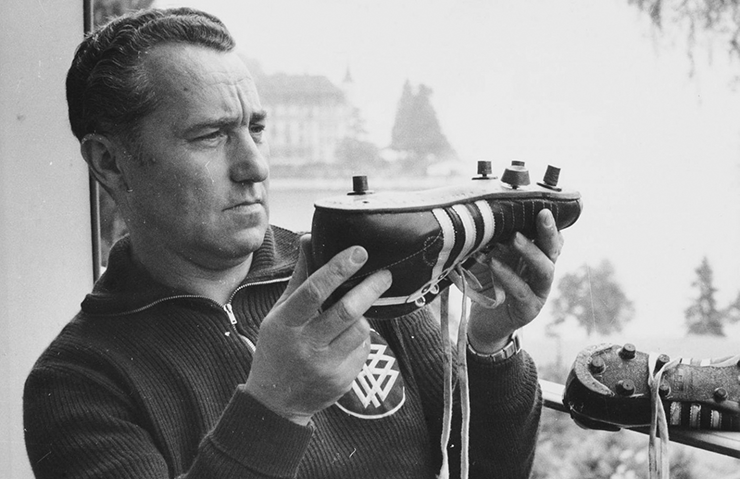
Adolf “Adi” Dassler (3 November 1900 – 6 September 1978) was a German entrepreneur who revolutionized the sportswear industry by founding “Adidas”, a brand that became synonymous with innovation, performance, and style. Born in Herzogenaurach, a small town in Bavaria, Dassler was introduced to the world of shoemaking through his father, who worked in a shoe factory. From a young age, he displayed a keen interest in creating footwear, driven by a desire to design shoes that could enhance athletic performance.
After returning from service in World War I, Dassler began experimenting with shoe designs in his mother’s laundry room in the early 1920s. His primary goal was to create specialized athletic footwear that would provide athletes with an edge in performance. With the support of his brother, Rudolf Dassler, Adolf established the “Dassler Brothers Shoe Factory” in 1924. Their company quickly gained a reputation for producing high-quality athletic shoes, and Adolf’s innovative approach to shoe design soon attracted attention from athletes.
One of Adolf Dassler’s most significant breakthroughs came during the 1936 Olympic Games in Berlin. Dassler personally convinced American sprinter Jesse Owens to wear a pair of his handcrafted spikes. Owens’ performance, winning four gold medals, not only cemented his place in history but also propelled Dassler’s shoes into the global spotlight. The success of this collaboration showcased Adolf’s ability to merge sports with technology, and it marked a turning point for his brand.
Taking into consideration the times he was living in, Adi Dassler joined the Nazi Party in 1933, a decision many German businessmen made to protect their enterprises under the regime. During World War II, the Dassler factory produced footwear for the German army. While Dassler’s membership is acknowledged, it appears to have been driven more by business pragmatism than ideology. Tensions between Adi and his brother Rudolf, who was more politically aligned with the Nazis, deepened during the war, contributing to their eventual split. After the war, Adi distanced himself from his Nazi association, focusing on rebuilding “Adidas” and leading it to global success.
When the relationship between Adolf and his brother Rudolf eventually deteriorated, leading to a split in the family business in 1948. Rudolf went on to establish his own brand, “Puma”, while Adolf rebranded his company as “Adidas”, a combination of his nickname “Adi” and the first three letters of his last name, “Dassler.” This marked the beginning of a fierce rivalry between the two brothers, with both brands becoming giants in the sportswear industry.
Under Adolf Dassler’s leadership, “Adidas” quickly grew into a global brand. Dassler was known for his hands-on approach to product development, constantly seeking feedback from athletes to improve his designs. He believed that the success of an athlete could be influenced by the quality of their footwear, and this philosophy drove “Adidas” to introduce several groundbreaking innovations. In 1949, the company introduced the first-ever shoes with removable studs, revolutionizing soccer footwear and allowing players to adapt their shoes to varying field conditions.
Throughout the 1950s and 1960s, “Adidas” expanded its product line to include apparel and accessories, becoming a leader not only in sports footwear but also in athletic fashion. The brand’s iconic three-stripe logo, introduced as a practical solution to reinforce shoes, became a symbol of quality and style, recognized across the world. By the time of Adolf Dassler’s death in 1978, “Adidas” had established itself as the go-to brand for athletes, from Olympic champions to professional soccer players.
Dassler’s influence extended beyond the realm of sports. As “Adidas” gained popularity, it began to penetrate the fashion world, becoming a staple in streetwear and youth culture. By the late 20th century, the brand had successfully bridged the gap between sports and fashion, with “Adidas” products being worn not just for athletic purposes but also as fashion statements. This crossover into popular culture has only grown stronger in the years following Dassler’s death, with “Adidas” becoming a favorite among musicians, artists, and fashion enthusiasts.
Adolf Dassler’s legacy is one of relentless innovation, an entrepreneurial spirit, and an unwavering commitment to quality. He transformed “Adidas” from a small workshop into a global powerhouse, influencing not just the way athletes perform but also the way people dress. His contributions to both the sports and fashion industries continue to be felt today, as “Adidas” remains one of the world’s most recognizable and influential brands. Through his vision, Adolf Dassler not only revolutionized athletic footwear but also helped shape the relationship between sports and fashion, leaving an enduring legacy that continues to inspire generations.
The post Adolf Dassler (Adidas) appeared first on The Fashiongton Post.
